Ever walked down a school hallway and felt your soul slowly leak out of your body? You know the ones I’m talking about. Beige walls, flickering fluorescent lights, and the distant, mournful echo of a lone locker slamming shut. It’s a vibe, alright. A really, really depressing one. It’s basically the architectural equivalent of a sigh.
I’ve spent more time than I’d like to admit with a staple gun in hand, trying to inject some life into these institutional-grade corridors.
As a parent, a volunteer, and frankly, just a human who dislikes soul-crushing environments, I’ve learned a thing or two. A school hallway isn’t just a path from Point A to Point B. It’s a massive, untapped canvas for inspiration, learning, and genuine joy.
So, if you’re staring down a hallway that looks like it was decorated by a committee of tired bureaucrats, you’re in the right place.
We’re going to talk about 15 colorful, brilliant, and totally achievable school hallway ideas that do more than just look pretty—they actually boost student motivation. Let’s turn those tunnels of tedium into corridors of creativity.
Table of Contents
- 1 1. Inspirational Quote Walls
- 2 2. Student Artwork Gallery
- 3 3. Seasonal Bulletin Boards
- 4 4. Interactive Learning Stations
- 5 5. Themed Hallway Murals
- 6 6. Achievement Recognition Displays
- 7 7. Motivational Word Clouds
- 8 8. Cultural Celebration Corners
- 9 9. DIY Paper Flower Installations
- 10 10. Reading Nook Hallway Spots
- 11 11. Science Project Showcases
- 12 12. Classroom Door Art Themes
- 13 13. Friendship & Kindness Walls
- 14 14. Hallway Photo Collages
- 15 15. Color-Coded Grade Sections
1. Inspirational Quote Walls
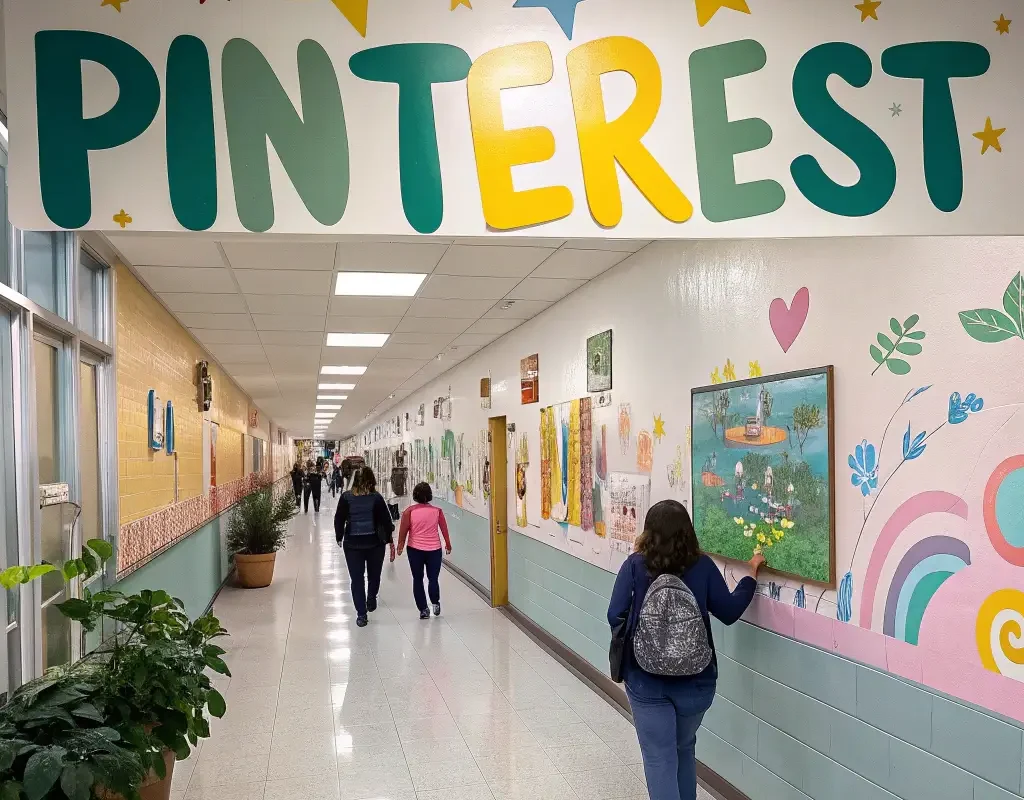
Let’s start with a classic. Words have power, right? An inspirational quote wall is like a silent, all-day pep talk for every student and staff member who walks by. It’s about creating an environment where positive messages are just part of the scenery.
Instead of a random assortment of feel-good phrases, think bigger. A great quote wall has a theme. Maybe it’s about resilience, celebrating quotes from historical figures who overcame massive obstacles. Or perhaps it’s focused on creativity, with words from artists, writers, and inventors. The key is to make it intentional.
How to Nail It
- Involve the Students: Don’t just pick quotes you like. Have students and teachers submit their favorites. This gives them ownership and makes the wall a true reflection of the school community. You’ll get some real gems, I promise.
- Design Matters: Don’t just slap black letters on a white wall. Use vibrant colors, different fonts, and dynamic layouts. You can use vinyl decals for a sharp, professional look, or get the art club involved to paint them directly on the wall. IMO, a hand-painted wall has way more character.
- Avoid the Cheesy: Please, for the love of all that is good, avoid the “Live, Laugh, Love” of the school world. We’re aiming for genuine inspiration, not something you’d find on a discount coffee mug. Dig a little deeper for quotes that make you think.
I once saw a middle school hallway where a huge wall just said, “You can do hard things.” That’s it. Simple, direct, and incredibly powerful for a kid staring down an algebra test. That’s the kind of impact we’re talking about.
2. Student Artwork Gallery
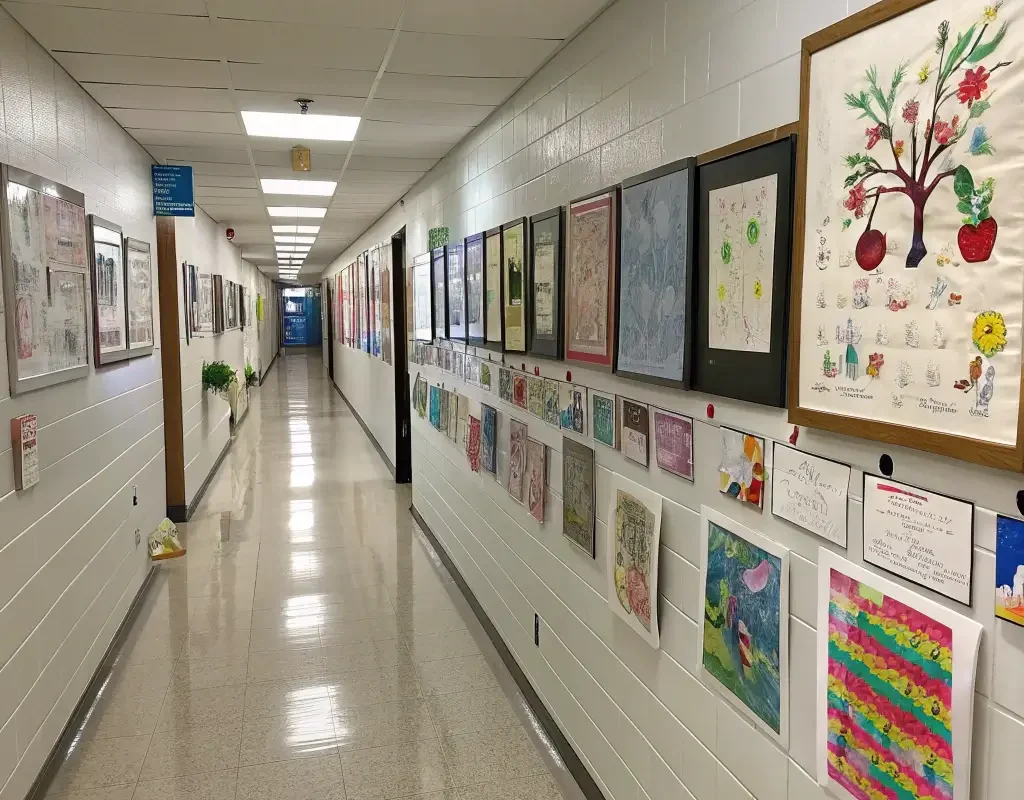
What’s more motivating for a budding artist than seeing their own masterpiece framed and displayed for the entire school to see? Absolutely nothing. A student artwork gallery turns a boring hallway into a vibrant, ever-changing museum of creativity.
This is more than just taping a few drawings to the wall. This is about treating student art with the respect it deserves. It tells students that their creative efforts are valued and celebrated. It transforms a simple walk to the library into an art walk.
Making Your Gallery Pop
- Invest in Real Frames: This is the game-changer. You don’t need expensive custom framing. Simple, cheap frames from a craft or dollar store work wonders. They immediately elevate the artwork and make it look official. Black frames with white matting create a classic, professional gallery feel.
- Rotate the Art Regularly: The gallery should be a living space. Rotate the artwork every month or every grading period. This ensures more students get a chance to be featured and keeps the hallway fresh and exciting. Announce the “new exhibition” in the school newsletter or morning announcements.
- Label Everything: Just like in a real museum, every piece should have a small label with the artist’s name, grade, and the title of the work (if they gave it one). This simple act gives the student artist a profound sense of pride and professionalism.
A friend of mine who teaches art says the gallery wall is the single best motivator she has. Kids work harder on their projects, knowing there’s a chance it could be “in the gallery.” How cool is that?
3. Seasonal Bulletin Boards
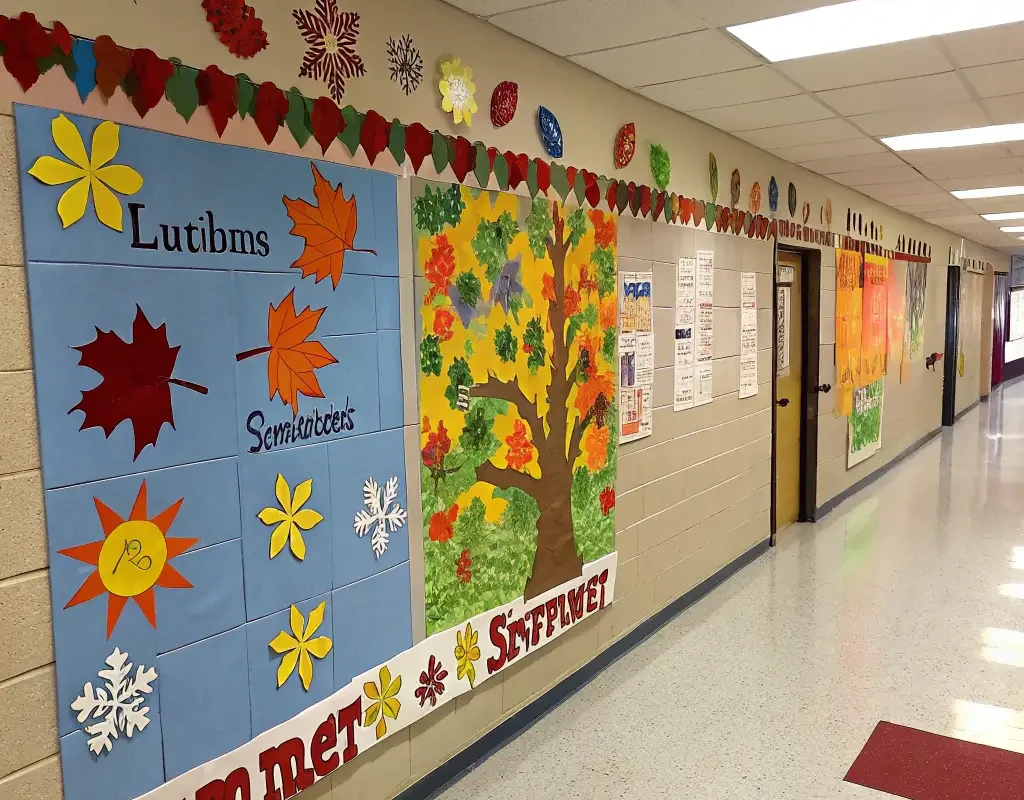
Okay, I know what you’re thinking. Bulletin boards? Groundbreaking. But hear me out. We’re not talking about a sad-looking pumpkin cut-out from 1998. I’m talking about dynamic, colorful, and thematically rich bulletin boards that change with the seasons and holidays.
These boards serve as visual anchors for the time of year, building a sense of community and shared experience. They break up the monotony of the school year with splashes of autumn oranges, winter blues, spring pastels, and summer brights.
Beyond the Basics
A great seasonal board goes beyond just aesthetics. Why not make it educational?
- Autumn: Forget just leaves. How about a board about the science of why leaves change color? Or a “Fall into a Good Book” theme with book jackets of recommended autumn reads?
- Winter: Instead of just snowflakes, create a board celebrating winter holidays and traditions from around the world. Or a “Cozy Up with a Math Problem” board featuring a challenging weekly puzzle.
- Spring: Flowers are great, but what about a board on “The Geometry of a Flower” or a display of student poetry about renewal and growth? The possibilities are endless.
The secret weapon for any bulletin board champion? A fabric background and a good border. Ditch the flimsy paper that rips and fades. A yard of cheap fabric from the craft store will last all year, won’t show staple holes, and adds a rich texture. It’s a small upgrade that makes a huge difference.
Also Read: 15 Cozy Hallway Lighting Ideas That Spark Joy Instantly
4. Interactive Learning Stations
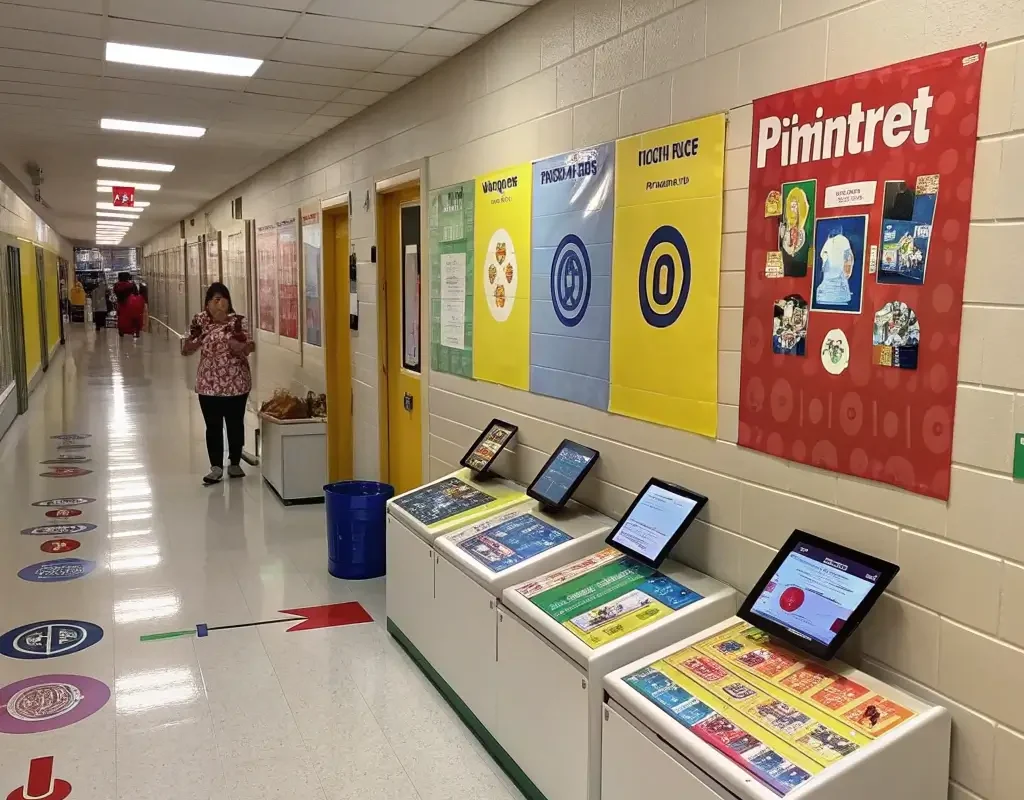
Who said learning has to stay in the classroom? Hallways are high-traffic areas, making them the perfect place for quick, engaging, and interactive learning opportunities. This turns passive travel time into active brain time.
An interactive station is any display that asks the student to do something—solve, touch, move, or contribute. It’s a fantastic way to reinforce concepts learned in class in a low-pressure, fun way.
Ideas for Interactive Stations
- The Riddle or Problem of the Week: Set up a small whiteboard or chalkboard with a new brain teaser, math problem, or riddle every Monday. Have a little box for students to submit their answers, and announce the winner on Friday.
- Magnetic Poetry Wall: Paint a section of the wall with magnetic paint and throw up a massive collection of word magnets. You’ll be amazed at the hilarious and profound poems that appear.
- Lego or Building Block Wall: Attach Lego baseplates to a section of the wall. Provide a bucket of Legos. This is amazing for younger kids (and, let’s be honest, older ones too) to practice fine motor skills and creative engineering.
- Mapping the World: Put up a giant world map and provide pins. Ask a question like, “Where in the world do you want to visit?” or “Where was your family born?” Students can place a pin, creating a beautiful visual representation of the school’s diverse community.
These stations spark curiosity. They get kids talking to each other and thinking critically, even if it’s just for 30 seconds between classes. The goal is to make learning an ambient part of the school environment.
5. Themed Hallway Murals
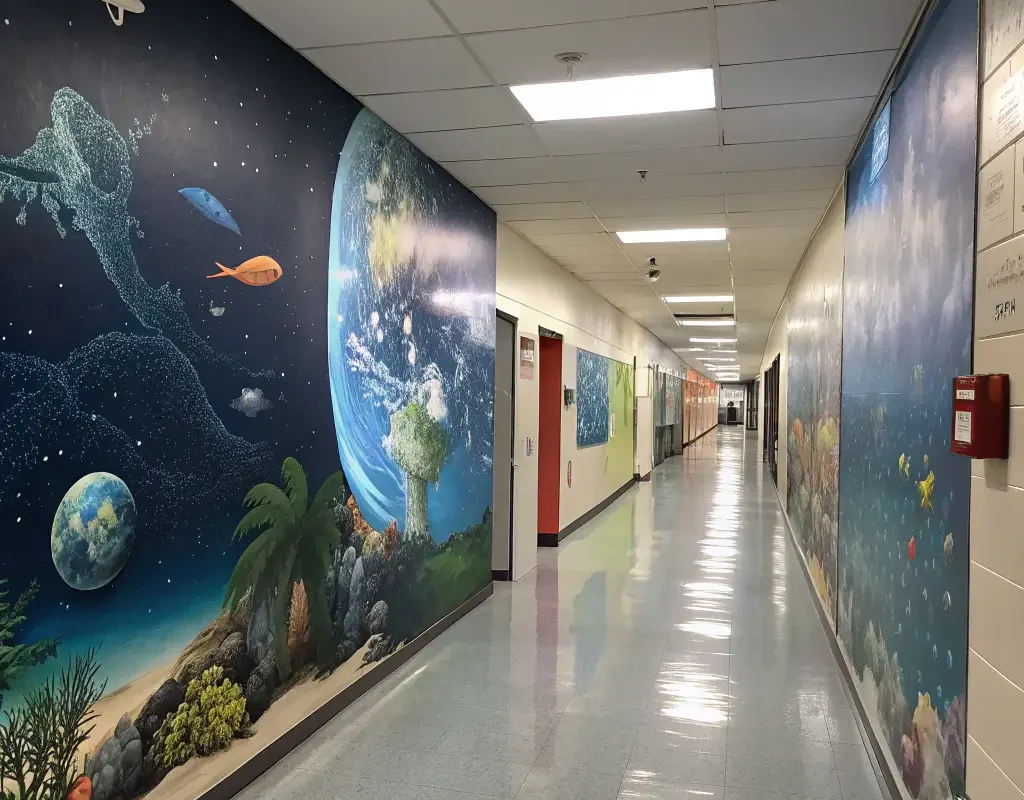
If you want to make a big, bold, lasting statement, nothing beats a mural. A hallway mural can completely transform the identity of a space, turning a generic corridor into a journey through the solar system, a dive into the deep sea, or a walk through a historical timeline.
This is a go-big-or-go-home idea, and it requires some planning. But the payoff is enormous. A mural becomes a landmark within the school, a source of immense pride, and a powerful teaching tool.
Bringing a Mural to Life
- Collaboration is Key: This is the perfect project for the art department, a talented parent volunteer, or even a local artist. But the best murals I’ve ever seen were the ones where students were heavily involved in the design and painting process. It becomes their mural.
- Choose a Meaningful Theme: The theme should resonate with the school’s values or curriculum. A history hallway could have a timeline mural. A science wing could feature the periodic table, constellations, or biological diagrams. A main entrance could showcase the school’s mascot and history.
- Plan the Logistics: You’ll need to think about paint (use durable, non-toxic paint), supplies, and scheduling. Painting might need to happen after school or on weekends. It’s a project, for sure, but a deeply rewarding one.
Imagine a first-grader walking through a hallway painted like a vibrant jungle, pointing out the different animals. Or a high school senior seeing a mural they helped paint four years earlier. A mural creates a legacy. It says, “This is a place where we create beautiful things together.”
6. Achievement Recognition Displays
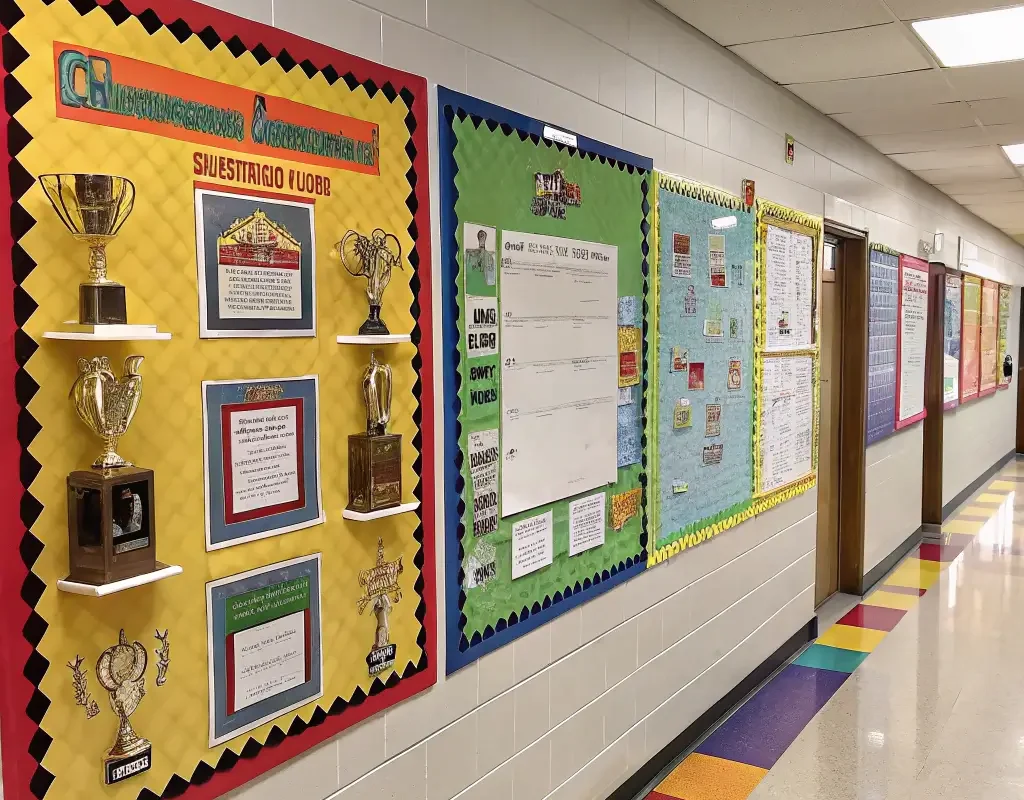
Every school has a place to recognize student achievement, but often it’s a dusty, forgotten trophy case in a dark corner. Yawn. We can do so much better. An achievement display should be dynamic, celebratory, and front-and-center.
This isn’t just about sports trophies or the honor roll. It’s about celebrating all kinds of success: “Most Improved Reader,” “Kindness King/Queen of the Week,” “Perfect Attendance,” or “Stellar Science Project.” When you broaden the definition of achievement, you give more students a chance to see themselves as successful.
Modernizing Achievement
- Go Digital: A digital screen or monitor can display a rotating slideshow of student achievements. This is easy to update and allows you to showcase photos and even short video clips. It’s modern, eye-catching, and much more engaging than a static list of names.
- “Spotlight On…” Boards: Create a dedicated, beautifully designed bulletin board for different types of achievements. Have one for academic stars, one for artistic talents, and one for sports heroes. Use high-quality photos of the students, not just their names.
- Make it Personal: Instead of just “Student of the Month: Jane Doe,” add a little bio. “Jane is our Student of the Month for her incredible work organizing the food drive and for always having a positive attitude. Her favorite book is The Giver and she wants to be a veterinarian.” This humanizes the achievement and makes it more relatable.
Let’s be real, that trophy from the 1987 soccer championship is cool for nostalgia, but it doesn’t motivate a kid in 2024. A dynamic achievement display shows students that success is happening right now, and they can be a part of it.
Also Read: 15 Fun Hallway Wall Decor Ideas to Add Personality
7. Motivational Word Clouds

Word clouds are a visually stunning and super simple way to fill a wall with positive energy. A word cloud is an image composed of words, where the size of each word indicates its frequency or importance. They are modern, graphic, and incredibly easy to customize.
You can create a giant word cloud decal for a main hallway or have smaller ones outside different departments. The words you choose can set the tone for the entire area.
Crafting the Perfect Word Cloud
- Department-Specific Clouds: Outside the gym, a word cloud could feature words like “Teamwork,” “Effort,” “Health,” “Perseverance,” and “Strength.” Outside the library, it might be “Imagine,” “Explore,” “Discover,” “Knowledge,” and “Adventure.” This visually reinforces the purpose of each space.
- School-Wide Values: Create a huge word cloud in the entryway based on your school’s core values. Words like “Respect,” “Integrity,” “Community,” “Curiosity,” and “Kindness” become a visual mission statement that everyone sees every single day.
- Student-Generated Content: This is my favorite way to do it. Use a simple online tool to survey students, asking them for one word that describes their school or what they hope to achieve. Then, generate a word cloud from their actual responses. It becomes a beautiful data visualization of the student body’s collective voice.
You can easily design these online (there are tons of free generators) and have them printed as a large vinyl wall decal. It’s a high-impact, relatively low-effort way to make a colorful and meaningful statement.
8. Cultural Celebration Corners

Schools are beautifully diverse places. A hallway can be a fantastic venue to celebrate the myriad of cultures that make up the school community. A “Cultural Celebration Corner” is a designated space that changes throughout the year to highlight different countries, traditions, and heritage months.
This does more than just decorate a hallway; it fosters inclusivity and global awareness. It sends a powerful message to students: “You are seen, you are valued, and your heritage is a part of who we are.”
How to Create a Meaningful Display
- Plan a Calendar: At the start of the year, map out which cultures or heritage months you’ll celebrate. Think Black History Month, Hispanic Heritage Month, Asian American and Pacific Islander Heritage Month, Diwali, Lunar New Year, etc.
- Gather Authentic Artifacts: Encourage families from the celebrated culture to lend items for the display—clothing, art, instruments, photos. This authenticity is what makes the display special. Just be sure to have a secure display case for valuable items!
- Make it Informative: The display should be educational. Include a map, fun facts, information about holidays, and profiles of important figures from that culture. QR codes linking to videos of traditional music or dance can make it interactive.
This idea is all about representation. When a student sees their family’s flag or a familiar holiday being celebrated in the school hallway, it creates an incredible sense of belonging and pride. It also teaches other students to appreciate the richness of the world around them.
9. DIY Paper Flower Installations

Looking for a serious “wow” factor on a shoestring budget? Look no further than a giant, three-dimensional paper flower installation. This is one of those ideas that looks incredibly expensive and complicated but is surprisingly affordable and achievable with a bit of teamwork.
Imagine a whole wall, or even a corner of the ceiling, bursting with colorful, oversized paper flowers. It’s whimsical, joyful, and utterly magical. It can transform a drab corner into an Instagram-worthy photo op. And yes, kids will totally take selfies there. 🙂
Getting it Done
- YouTube is Your Best Friend: There are thousands of tutorials online for making every kind of paper flower imaginable, from simple roses to complex peonies. You can find templates and step-by-step video instructions for all skill levels.
- Make it a Group Project: This is the perfect activity for a PTA work night, an art club project, or even an all-school assembly. Many hands make light work, and it’s a really fun, collaborative process. Set up stations for cutting, curling petals, and assembling.
- Go for Variety: The key to a stunning installation is variety. Use different types of flowers, a range of sizes (from tiny buds to massive blossoms), and a well-planned color palette. An ombre effect, going from light to dark, can be particularly breathtaking.
The materials are simple: just cardstock, scissors, and a hot glue gun. Yet the result is a piece of large-scale art that brings a sense of wonder and enchantment to the school. It’s a powerful reminder that with simple materials and a bit of creativity, you can make something truly beautiful.
Also Read: 15 Perfect Small Hallway Decor Ideas to Elevate Your Entry
10. Reading Nook Hallway Spots
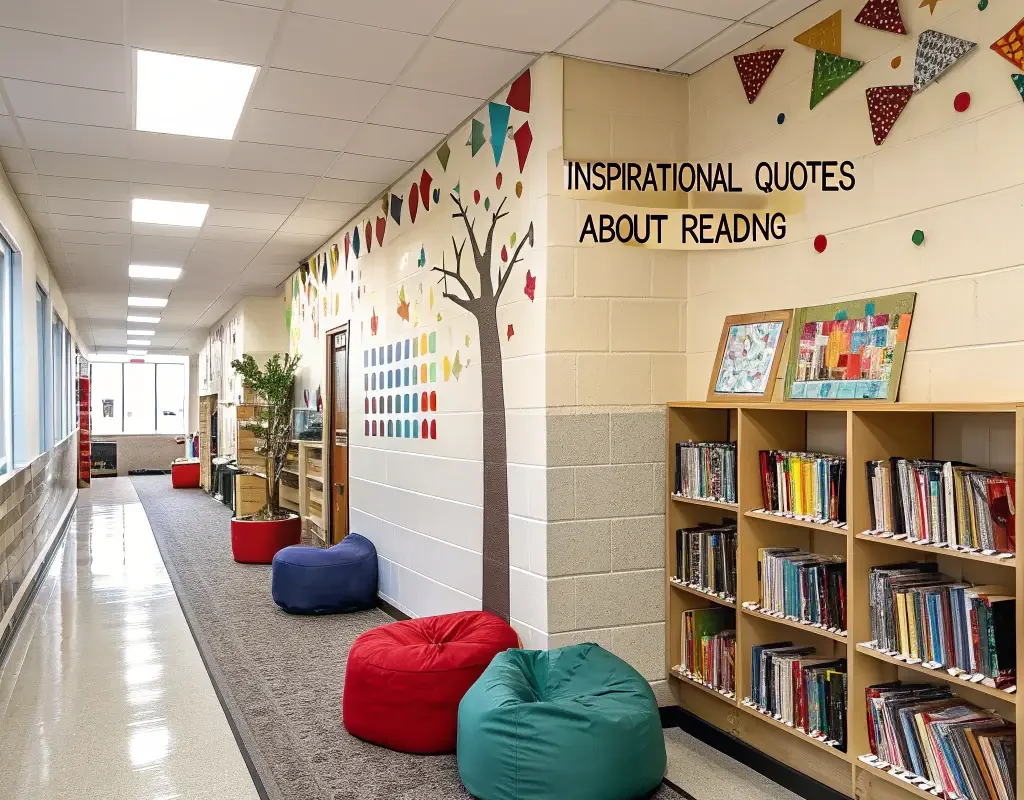
Hallways can be loud, chaotic places. Why not carve out a few small pockets of peace and quiet? A hallway reading nook is a small, cozy area with comfortable seating and a small selection of books, designed for a student who needs a moment to decompress or get lost in a story.
These nooks are especially powerful for students who may feel overwhelmed by the social pressures of the playground or cafeteria. It gives them a safe, quiet alternative. It also promotes a culture of reading for pleasure, making it a visible and accessible activity.
Creating the Perfect Nook
- Location, Location, Location: Find a low-traffic area, like the end of a hallway, an unusually wide corridor, or an unused alcove under a staircase. The goal is to be out of the main flow of traffic.
- Comfort is Key: You’ll need some comfy seating. Think beanbag chairs, floor cushions, or a small, sturdy bench with pillows. A soft rug can also help define the space and make it feel cozier.
- The Books: Stock the nook with a small, rotating collection of high-interest books and graphic novels. You don’t need a full library—just a few dozen engaging titles will do. Ask the school librarian for recommendations or donations of well-loved paperbacks.
FYI, you’ll need to set some ground rules for the nook to ensure it remains a quiet space for one or two students at a time. But creating these little sanctuaries can have a huge impact on student well-being and fosters a school-wide love of reading.
11. Science Project Showcases

The annual science fair is a fantastic event, but what happens to all that amazing work afterward? Usually, it gets taken home and disappears. A science project showcase in the hallway allows those projects to live on, inspiring other students and celebrating the hard work that went into them.
This turns a hallway into a living laboratory. Students walking by can see what their peers are investigating, from the classic baking soda volcano to more complex studies on plant phototropism or simple circuits.
Showcasing Science Effectively
- Select the Best of the Best: You probably can’t display every single project. Work with the science teachers to select a dozen or so of the most interesting, well-executed, and visually appealing projects from different grade levels.
- Provide a Sturdy Display: These projects need to be displayed on tables or sturdy shelves, not just on the floor. Ensure there’s enough space for people to walk by without knocking anything over.
- Add Interactive Elements: If a project has a safe, interactive component (like a button to press or a wheel to turn), let students engage with it! For more complex projects, you could add a QR code that links to a short video of the student explaining their experiment. This brings the project to life.
This is a fantastic way to promote STEM/STEAM within the school. It demystifies the scientific process and shows students that science isn’t just something that happens in a textbook—it’s something they can do. It sparks curiosity and might just inspire the next great scientist.
12. Classroom Door Art Themes

Why should hallway decor stop at the walls? Classroom doors are perfect individual canvases for creativity and a great way to give each class its own unique identity. A school-wide door decorating contest or theme can create a wave of excitement and friendly competition.
The theme could be anything: “Our Favorite Books,” “Destinations Around the World,” “When I Grow Up,” or tied to a seasonal holiday. It gives each teacher and their class a small piece of hallway real estate to make their own.
Making Doors Dynamic
- Set a Theme, But Allow Freedom: Providing a broad theme gives everyone a starting point, but let individual creativity shine. The results will be much more interesting than if you prescribe exactly what to do.
- Make it a Contest (With Fun Prizes): A little competition never hurt anyone. Offer prizes for different categories: “Most Creative,” “Funniest Door,” “Best Use of Theme,” etc. The prize doesn’t have to be big—bragging rights and a pizza party for the winning class are usually more than enough motivation.
- 3D is Awesome: The best doors often have three-dimensional elements that pop out into the hallway. Think paper chains, cotton ball clouds, or characters built from construction paper. It makes the hallway a more tactile and engaging experience.
Walking down a hallway where every door is a unique work of art is just plain fun. It shows off the personality of each classroom and teacher, and it makes the school feel like a vibrant, creative community.
13. Friendship & Kindness Walls
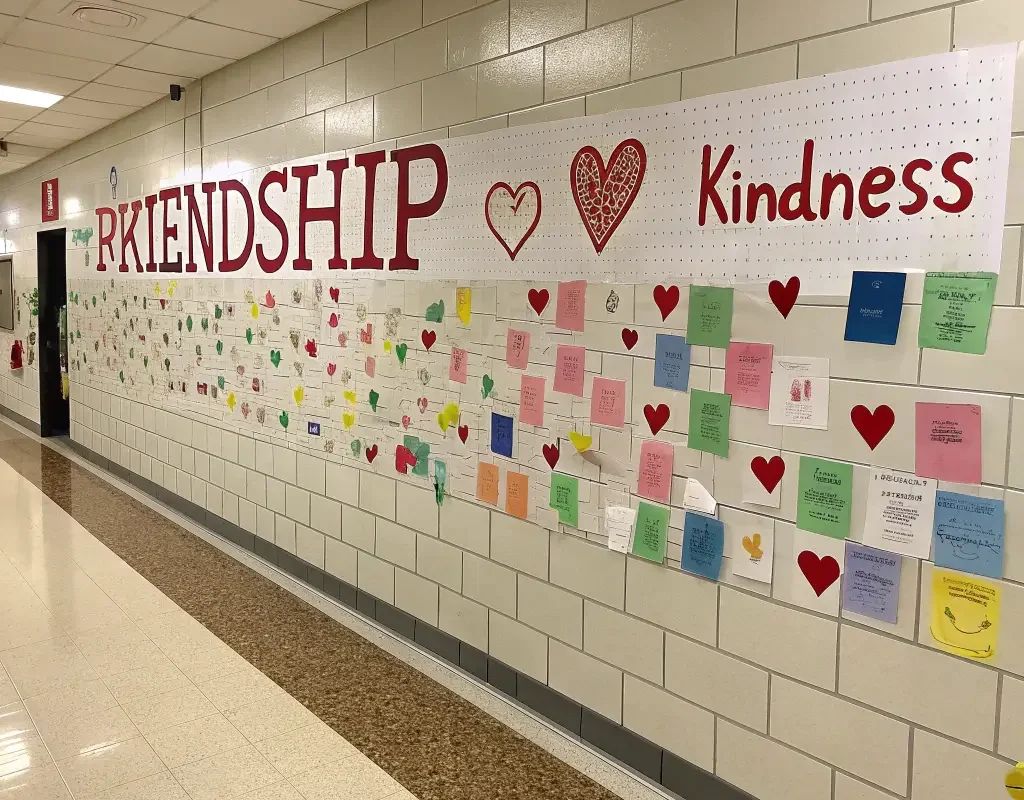
In a world that can always use more kindness, why not dedicate a wall to it? A Friendship and Kindness Wall is an interactive space where students can publicly acknowledge the good deeds of others. It’s a powerful tool for building a positive school culture.
This isn’t about big, grand gestures. It’s about celebrating the small, everyday acts of kindness that often go unnoticed: sharing a snack, helping someone who dropped their books, giving a compliment.
Building a Culture of Kindness
- The “Take One, Leave One” Model: Set up a board with two sections. One section has slips of paper with pre-written kindness challenges (e.g., “Say hello to someone new,” “Give someone a high-five”). Students can take a challenge. The other section is for “Kindness Shout-Outs,” where students can write down a kind act they witnessed and post it for all to see.
- Post-It Note Power: The simplest version is just a big, open board titled “Wall of Kindness” with a stack of Post-it notes and pens nearby. Students can anonymously or publicly write a thank you or a shout-out to a friend or classmate and stick it on the wall.
- Keep it Positive: You’ll need to set a clear expectation that this is a positive-only space. A quick check by a teacher or staff member each day can ensure the messages stay on-topic and kind.
Reading a wall full of positive messages is an instant mood-lifter. It visually reinforces the idea that kindness is a core value of the school and encourages students to be more mindful of their interactions with one another.
14. Hallway Photo Collages

A photo collage is a window into the life of the school. It’s a warm, personal, and wonderful way to showcase the real people and real moments that make your school a community, not just a building.
We’re not talking about the formal, posed school pictures. We’re talking about candid shots from the school play, the field trip to the pumpkin patch, the messy fun of field day, and students laughing in the cafeteria. These are the moments that capture the spirit of the school.
Creating a Memorable Collage
- Designate a “School Spirit” Photographer: Have a staff member or a responsible student from the yearbook club be in charge of capturing these candid moments throughout the year.
- Get Digital, Then Print: It’s easiest to collect digital photos and then get them printed affordably. You can create a huge collage on a bulletin board or even frame a massive poster-sized collage.
- Theme Your Collages: You could have one board dedicated to “Spirit Week,” another to “Club Life,” and another to “The Arts.” This helps organize the joyful chaos and tells a clearer story.
When students, staff, and parents see themselves and their friends in these photos, it creates a powerful sense of connection and shared history. It says, “You belong here. You are part of this story.” It’s a simple idea with a massive emotional impact.
15. Color-Coded Grade Sections

Last but not least, let’s talk about a big-picture idea that is both organizational and psychological: color-coding your hallways by grade level or department. This is a powerful wayfinding tool that also has a surprisingly strong effect on school spirit and identity.
Think about it: the 6th-grade hallway could be “The Blue Hall,” the 7th-grade hall is “The Green Hall,” and so on. You can use paint, colored floor tiles, or even just colored lockers and bulletin board trims to establish the theme.
The Benefits of Color-Coding
- Easy Navigation: For new students, substitute teachers, and visiting parents, this makes navigating a large school infinitely easier. “Just head to the yellow hallway” is much simpler than a complex set of directions.
- Sense of Identity: It gives each grade level a subtle sense of team identity. They aren’t just 7th graders; they are the residents of the Green Hall. This can build a positive sense of community and friendly competition between grades.
- Psychological Impact: Colors affect mood. You can be intentional with your choices. Blue and green are calming and can promote focus, making them great for academic wings. Yellow and orange are energetic and cheerful, perfect for main entryways or younger grade levels.
This is a larger-scale project, but it can be implemented over time. Maybe you start by painting one accent wall in each hallway the designated color. The visual cohesion and organizational clarity it brings are well worth the effort.
Wrapping It All Up
So, there you have it. Fifteen ideas to wage war on beige and turn your school’s hallways from depressing passages into dynamic, motivational spaces. The common thread here? Intentionality and student involvement.
The most powerful hallway displays aren’t the ones that cost the most money; they’re the ones that reflect the students and celebrate the vibrant life happening inside the school.
They send a clear message: this is a place where you matter, where your work is valued, and where creativity and kindness are a part of the very walls around you.
Now, which idea are you going to tackle first? Pick one, grab a staple gun (or a paintbrush), and start making your school a more colorful, inspiring place to be.
